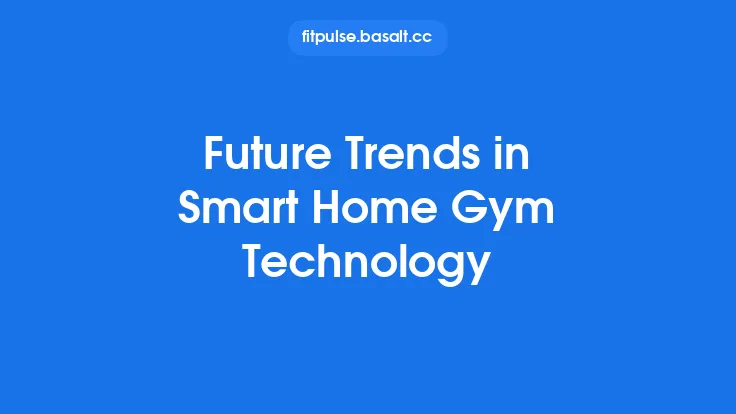The landscape of gamified fitness is evolving at a breakneck pace, driven by advances in artificial intelligence, immersive media, biometric sensing, and decentralized technologies. While today’s platforms already blend exercise with points, streaks, and social sharing, the next wave will reshape how users experience, interact with, and derive value from their workouts. This article explores the most compelling future trends poised to redefine gamified fitness and social engagement, offering a forward‑looking view that remains relevant regardless of specific device releases or app updates.
AI‑Driven Personalization and Adaptive Gameplay
Artificial intelligence is moving beyond simple recommendation engines to become the core engine of fitness gamification. Future platforms will employ deep learning models that continuously ingest data from wearables, environmental sensors, and user‑generated content to:
- Generate Dynamic Difficulty Curves – Instead of static levels or preset challenges, AI will adjust the intensity, duration, and complexity of workouts in real time, ensuring each session remains within the user’s optimal “zone of proximal development.”
- Craft Personalized Narrative Arcs – By analyzing a user’s historical preferences, mood signals (e.g., heart‑rate variability), and social context, AI can weave a story that evolves with the athlete, turning a routine cardio session into a quest to rescue a virtual world or unlock a new chapter in a personal saga.
- Predict and Prevent Burnout – Predictive models will flag patterns that precede overtraining or disengagement, prompting the system to suggest recovery activities, alternate modalities, or social support interventions before fatigue becomes a barrier.
These capabilities rely on federated learning approaches that keep raw sensor data on the device while still benefiting from collective intelligence across the user base, preserving performance without compromising user autonomy.
Immersive AR/VR Environments for Social Workouts
Augmented and virtual reality are set to become the primary stage for shared fitness experiences. Two complementary pathways are emerging:
- Mixed‑Reality Outdoor Play – AR glasses or head‑up displays can overlay virtual obstacles, power‑ups, and cooperative objectives onto real‑world routes. Runners can see a digital “energy field” that expands when a friend matches their pace, encouraging spontaneous collaboration without leaving the park.
- Fully Virtual Social Gyms – In VR, users inhabit avatars that occupy a shared digital studio. Haptic gloves and full‑body trackers translate real movements into the virtual space, allowing participants to see each other’s form, exchange high‑five gestures, and compete in synchronized routines. The sense of presence is amplified by spatial audio that mimics the acoustics of a real gym, fostering a feeling of community that transcends geographic boundaries.
Both modalities will leverage low‑latency edge computing to keep interactions fluid, while standardized SDKs will enable developers to create cross‑compatible experiences that work across a range of headsets and AR glasses.
Biometric and Neurofeedback Integration
Future gamified fitness platforms will read far more than steps and heart rate. Emerging sensor suites will capture:
- Electromyography (EMG) Signals – Direct measurement of muscle activation patterns can inform the game engine about the quality of each rep, rewarding true muscular effort rather than just movement completion.
- Electroencephalography (EEG) and Heart‑Rate Variability (HRV) – Real‑time neuro‑cardiac data will allow the system to gauge mental focus and stress levels, adapting challenges to maintain a balanced arousal state. For example, a high‑intensity interval might be softened if the user’s EEG indicates cognitive overload.
By integrating these signals, platforms can create a richer feedback loop where the “score” reflects both physical output and mental engagement, encouraging holistic health development.
Cross‑Platform Interoperability and Open Ecosystems
The next generation of gamified fitness will be less siloed. Key trends include:
- Standardized Data Schemas – Initiatives such as the Open Fitness Data (OFD) specification will enable seamless data exchange between wearables, smart home devices, and fitness apps, allowing a user’s performance metrics to flow freely across ecosystems.
- Modular Plugin Architecture – Developers will be able to add “experience modules” (e.g., a new AR quest line or a blockchain‑based reward system) without rewriting the core app, fostering a marketplace of community‑driven extensions.
- Unified Social Graphs – Rather than isolated friend lists per app, a federated social graph will let users connect across platforms, bringing together runners from Strava, cyclists from Zwift, and gamers from a VR fitness hub under a single identity.
Interoperability not only reduces friction for users but also encourages innovation by lowering the barrier to entry for niche developers.
Blockchain, Tokenization, and New Economic Models
Decentralized technologies will introduce novel incentive structures that go beyond traditional points and badges:
- Utility Tokens for Real‑World Value – Earned tokens can be exchanged for discounts on equipment, access to premium virtual locations, or even charitable donations, creating a tangible economic loop that reinforces healthy behavior.
- Proof‑of‑Activity Consensus – Similar to proof‑of‑work in cryptocurrency, a user’s verified workout data can contribute to network security or governance, granting them voting rights on platform updates.
- Non‑Fungible Achievement Badges – NFTs can represent unique milestones (e.g., completing a marathon in a virtual world) that users can display, trade, or embed in their digital portfolios, adding a layer of scarcity and collectibility.
These mechanisms will be designed with low‑energy consensus algorithms to avoid the environmental concerns associated with early blockchain implementations.
Social Graph Evolution and Contextual Interaction
Future social engagement will be driven by context‑aware connections rather than static friend lists:
- Dynamic “Workout Pods” – Algorithms will form temporary groups based on location, fitness level, and shared goals, allowing users to join spontaneous challenges that dissolve once the session ends.
- Interest‑Based Narrative Communities – Users who gravitate toward specific storylines (e.g., sci‑fi exploration, fantasy quests) will be clustered together, receiving tailored content and collaborative objectives that evolve with the group’s progress.
- Cross‑Domain Social Overlays – A user’s fitness activity could intersect with other lifestyle domains—such as music streaming or nutrition tracking—creating multi‑modal social experiences (e.g., a synchronized playlist that adapts to the group’s collective heart rate).
By making social connections fluid and purpose‑driven, platforms will keep interactions fresh and reduce the fatigue that can arise from static friend networks.
Real‑Time Collaborative Metrics and Shared Experiences
Beyond leaderboards, the next wave will emphasize cooperative data visualizations:
- Shared Energy Pools – Teams can contribute “energy” generated from their workouts to a communal meter that unlocks group rewards, encouraging mutual support without direct competition.
- Live Motion Mirroring – In AR/VR sessions, participants can see a ghost overlay of a teammate’s form, enabling instant technique correction and synchronized movement.
- Ambient Environmental Feedback – Smart lighting or ambient sound systems in a user’s home can change hue or tempo based on the collective performance of a group, turning the physical environment into a responsive social canvas.
These collaborative metrics transform data from a personal scoreboard into a shared narrative that reinforces community cohesion.
Haptic Feedback and Sensory Augmentation
Physical sensations will become an integral part of gamified fitness:
- Wearable Haptic Suits – Distributed vibration motors can simulate “impact” when a user collides with a virtual obstacle or provide gentle nudges to correct posture.
- Temperature Modulation – Smart fabrics capable of heating or cooling can reflect in‑game environments (e.g., a chilly breeze when traversing a virtual mountain), deepening immersion.
- Force‑Feedback Resistance Bands – Integrated actuators can dynamically adjust tension in resistance bands, turning a static strength exercise into a variable‑resistance quest that reacts to in‑game events.
By aligning physical sensations with digital cues, platforms will close the loop between perception and action, making workouts feel more like interactive play.
AI‑Generated Narrative and Storytelling in Fitness
Narrative will shift from static storylines to procedurally generated adventures:
- Branching Quest Trees – AI will craft story arcs that adapt to a user’s performance, preferences, and social interactions, ensuring each session feels unique.
- Character Companion Evolution – Virtual coaches or mascots will evolve based on the user’s achievements, offering personalized dialogue, challenges, and emotional support that feels earned rather than scripted.
- World‑State Persistence – Collective actions of a community can alter the shared game world (e.g., unlocking a new city district after a global mileage milestone), giving users a sense of lasting impact.
Procedural storytelling ensures longevity, as the content can scale indefinitely without requiring manual authoring.
Integration with Smart Home and Urban Infrastructure
Fitness gamification will extend beyond the individual device to the broader environment:
- Smart‑Gym Equipment Sync – Treadmills, rowing machines, and stationary bikes will communicate directly with the game engine, translating mechanical resistance and speed into in‑game physics without latency.
- City‑Scale Fitness Trails – Municipalities will embed BLE beacons and AR markers along public pathways, enabling city‑wide quests that encourage exploration while collecting anonymized environmental data (e.g., air quality).
- Home Automation Triggers – Completing a workout could automatically dim lights, start a post‑exercise playlist, or adjust thermostat settings, creating a seamless transition from activity to recovery.
These integrations blur the line between digital and physical spaces, turning everyday environments into interactive fitness playgrounds.
Ethical Considerations and Sustainable Design
While technology opens new possibilities, responsible design remains essential:
- Algorithmic Transparency – Users should have insight into how AI determines difficulty adjustments or narrative outcomes, fostering trust and allowing informed consent.
- Inclusivity by Design – Adaptive interfaces must accommodate a wide range of abilities, cultural contexts, and language preferences, ensuring that gamified experiences are accessible to all demographics.
- Energy‑Efficient Computing – Edge processing and low‑power AI models will minimize the carbon footprint of continuous sensor streaming and real‑time rendering, aligning the health of users with planetary health.
Embedding these principles from the outset will help future platforms grow sustainably and ethically.
Looking Ahead: A Confluence of Technologies
The future of gamified fitness and social engagement will be defined by the convergence of several powerful trends:
- AI that learns and adapts at the individual level while respecting privacy through federated models.
- Immersive AR/VR that turns any space into a shared playground, supported by low‑latency edge networks.
- Deep biometric sensing that captures the full spectrum of human performance, from muscle activation to mental focus.
- Open, interoperable ecosystems that let data and social connections flow freely across devices and platforms.
- Decentralized economic layers that give real‑world value to virtual achievements, fostering new motivations beyond simple points.
When these elements coalesce, the experience of working out will transform from a solitary routine into a richly interactive, socially connected, and personally meaningful adventure—one that evolves with each user, each community, and each technological breakthrough.



